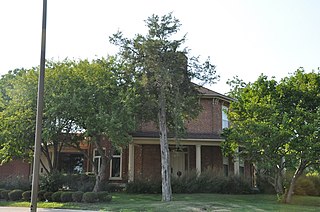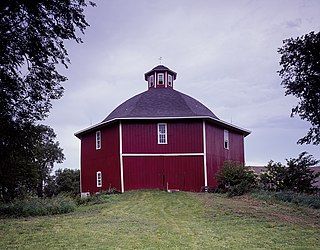
A round barn is a historic barn design that could be octagonal, polygonal, or circular in plan. Though round barns were not as popular as some other barn designs, their unique shape makes them noticeable. The years from 1880–1920 represent the height of round barn construction. Round barn construction in the United States can be divided into two overlapping eras. The first, the octagonal era, spanned from 1850–1900. The second, the true circular era, spanned from 1889–1936. The overlap meant that round barns of both types, polygonal and circular, were built during the latter part of the nineteenth century. Numerous round barns in the United States are listed on the National Register of Historic Places.

The Sinnett Octagon House built in 1855 is a historic octagonal house in Muscatine, Iowa. The two-story brick home with wrap-around porch and windowed cupola is now used as an office building.

The Langworthy House, also known as the Octagon House, is an historic building located in Dubuque, Iowa, United States. Built in 1856, it was designed by local architect John F. Rague for local politician Edward Langworthy. The two-story brick home features tall windows, a columned entry, and a windowed cupola. Langworthy and three of his brothers were among the first settlers in Dubuque. They were partners in a lead mine, helped to build the territorial road between Dubuque and Iowa City, they farmed, invested in real estate, and they owned a steamboat and a mercantile exchange. The house has been passed down through Langworthy's descendants. It was individually listed on the National Register of Historic Places in 1975, and it was included as a contributing property in the Langworthy Historic District in 2004.

The William Waterfield House, also known as the Waterfield Octagon House, is a historic building located in Raymond, Iowa, United States. Built in 1867, it was added to the National Register of Historic Places on October 19, 1978. Waterfield was a New Jersey native who settled in Iowa in 1856 as a farmer, eventually operating a hotel in Raymond, possibly in this house. He was a student of phrenology and as a result he built this octagon house. Its 2-foot (0.61 m) thick walls are covered with stucco, which hides its exterior of ashlar limestone. The house is capped with an unusual hipped roof that is formed by extending its east and west roof planes.

The Octagon Barn, Richland Township is an historic building located near Jamaica in Guthrie County, Iowa, United States. Built in 1881, this is the oldest known octagon-shaped barn extant in Iowa. It measures 70 feet (21 m) in diameter. The modified hip roof, heavy timber construction, rectangular plan, and general purpose use marks this as a Coffin type. It was named for Lorenzo S. Coffin who is thought to have built the first round barn in the state. This barn was listed on the National Register of Historic Places in 1986. The metal band Slipknot filmed the music video for Psychosocial here.

The Secrest Octagon Barn is a historic building located near Downey in rural Johnson County, Iowa, United States. It was constructed in 1883 by master builder George Frank Longerbean for Joshua Hunt Secrest as a hay barn-horse stable. The octagonal barn measures 80 feet (24 m) in diameter. It features red vertical siding and a sectional bell shaped roof that is supported by hand-laminated beams. The octagon-shaped cupola has the same roof shape as the barn. It was listed on the National Register of Historic Places in 1974.

The Fobes Octagon Barn is a historic building located south of Lanesboro, Iowa, United States. It was built in 1883, and at the time of its nomination it was one of 14 octagon-shaped barns from the 19th-century left in Iowa. The barn has a diameter of 66 feet (20 m) and features a stone foundation, and a hip roof with a square cupola on top. The modification of the roof suggests this is a "Coffine type" structure similar to others built by Lorenzo Coffin. The general purpose barn has two granaries, horse stalls, and the rest of the space is open for agricultural machinery. It was listed on the National Register of Historic Places in 1986.

The Roberts Octagon Barn built in 1883 is an historic octagonal barn located on CR W62 near Sharon Center, Johnson County, Iowa. On June 30, 1986, it was added to the National Register of Historic Places.

The Round Barn, Washington Township is a historic building located south of Janesville, Iowa in Black Hawk County, United States. It was built in 1917 as a dairy barn. The building is a true round barn that measures 60 feet (18 m) in diameter. The structure is constructed in clay tile and features an aerator and a two-pitch roof. It was built around a silo with a water tank on top of it. While that is typical of this type of structure, it is the only one known to exist in Iowa. It has been listed on the National Register of Historic Places since 1986.

The Grimes Octagon Barn is an historic building located near West Union in rural Fayette County, Iowa, United States. It was built by Joe Butler in 1880 for M.W. Grimes. The building is an octagon that measures 65 feet (20 m) in diameter. It is one of 14 known 19th-century octagon barns that still exist on an Iowa farm. The barn features red metal siding, a roof composed of wedge-shaped sections and a hay dormer. The sectional roof marks it as a Stewart type that was named for the New York farmer and agricultural editor Elliott W. Stewart, who designed the prototype in 1874. The barn has been listed on the National Register of Historic Places since 1986.

The Lenox Round Barn is a historic building that is part of the Taylor County Historical Museum in Bedford, Iowa, United States. The true round barn was built somewhere between 1905 and 1907. The building measures 64 feet (20 m) in diameter and 55 feet (17 m) in height. It features white vertical siding, a large cupola, and a two-pitch roof. The barn was thought to have been designed and built by J.E. Cameron on his farm 5 miles (8.0 km) south of Lenox. It remained on the family's farm until 1996 when they donated it to the Taylor County Historical Society. The barn was moved to their museum grounds in May 1998. It has been listed on the National Register of Historic Places since 1999. Its primary significance is its architectural value. Of primary interest are the steep-pitched free-standing roof, the tornado-resistant support beams, and the pieshaped circular grain bins.

The W.J. Buck Polygonal Barn was a historical structure located near Diagonal in rural Ringgold County, Iowa, United States. It was built in 1907 and has been listed on the National Register of Historic Places since 1986. The building measures 65 feet (20 m) around. The structure of the barn was basically a central octagon with a sectioned roof. Double pitch sheds surrounded the barn characterizing it as an encircling wing type. The central section was six-sided and the wing was nine-sided. The plan appears to be the same as the one for the Lloyd Z. Jones stock barn published in Wallaces' Farmer on January 16, 1903 and again on October 25, 1907 and June 17, 1910. It has subsequently been torn down.

The McCoy Polygonal Barn is a historic building located near Hepburn in rural Page County, Iowa, United States. It was built in 1914 as a hog sale barn. The hexagon shaped building features white horizontal siding, a large monitor with 12 windows, and an aerator. It is only one of five barns known to have been built on a farm in Iowa with a large monitor. Because of this building's original use as a sale barn it was needed to provide the required amount of light. The barn has been listed on the National Register of Historic Places since 1986.

The Dyas Hexagonal Barn is an historical building located near Bellevue in rural Jackson County, Iowa, United States. Built in 1921, it features red horizontal siding, a tin roof and a central wood stave silo that extends through the roof. The building is hexagonal in shape and measures 50 feet (15 m) around. It is one of four known round barns that originally had a flat or near flat roof that was built on an Iowa farm. It has been listed on the National Register of Historic Places since 1986.

The Polygonal Barn, Van Buren Township was a historic building located in Van Buren Township in rural Jackson County, Iowa, United States. It was built in 1920 by Gus Klenney as a sale barn. They house livestock that are shown and sold to buyers. It is not known what livestock were sold here. The building was octagonal in shape and measured 50 feet (15 m) in diameter. It was listed on the National Register of Historic Places in 1986. The structure has subsequently been torn down.

The Charles B. Reynolds Round Barn was a historic building located near Doon in rural Lyon County, Iowa, United States. It was built in the summer of 1904. In the early 1920s, the original conical roof was damaged due to a windstorm and replaced with a gambrel roof. The building was a true round barn and featured white horizontal siding, a two-pitch sectional roof and an octagon louvered cupola. The barn has been listed on the National Register of Historic Places since 1999. The barn was razed in September 2009.

The Octagon Barn, Otter Township is a historic building located near Milo in rural Warren County, Iowa, United States. It was built in 1900 as a horse and dairy barn. The octagon-shaped building measures 54 feet (16 m) in diameter. The structure features a tall center section with a winged shed around it. It is covered in red horizontal siding and is topped by a sectional conical roof. It has been listed on the National Register of Historic Places since 1986.

The Octagon Round Barn, Indian Creek Township is an historic building located near Iowa Center in rural Story County, Iowa, United States. It was built in around 1880 as a dairy barn. The octagon-shaped building measures 50 feet (15 m) in diameter. The modified hip roof, heavy timber framing, rectangular interior plan, and general purpose use marks this as a design influenced by Lorenzo S. Coffin, who built the first round barn in Iowa. It has been listed on the National Register of Historic Places since 1986. The barn has deteriorated significantly and it is essentially a pile of wood now.

Coffin's Grove Stagecoach House, also known as the Henry Baker House, was a historic building located west of Manchester, Iowa, United States. Coffin's Grove was named for Clement Coffin who settled in the area in 1840. His son-in-law Henry Baker joined him the following year. The house was built in 1855 to accommodate the increase in travelers passing through the area. It served as a hotel, post office and the second floor was used for community functions like dances. The two-story Colonial style was unusual for a structure this far west. It is typically found in Ohio. The house featured a foundation of limestone quarried on the property and brick that was kilned here. Across the road from where the house was located are the remnants of barns built in 1849. They were the first frame barns in the Delaware County. The house was listed on the National Register of Historic Places in 1975.

















